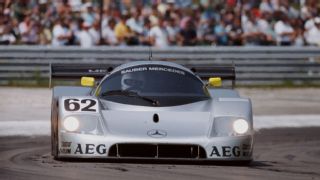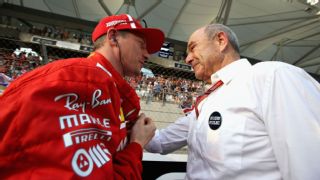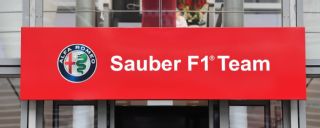|
As you might expect, the complete rebranding of Sauber has brought plenty of PR puff about "The full return of the historic Alfa Romeo motor racing brand to F1". In truth, there is about as much connection between the current team in Switzerland and makers of the 1950s championship-winning Alfetta 158 as there is between Liberty Media and Bernie Ecclestone. More important is, hopefully, the assured future of a team with a remarkable reputation for survival. And just as significant in the opposite direction comes the final fading of an association with a man who did himself and motorsport proud. Peter Sauber actually used to sell Alfa Romeos but the publicity people better not go there because this was back in the days when, as Sauber says: "I had no relationship or feeling for cars and this was just to make money!" The contradiction goes even further when he explains the finance was needed to support the building of his first race car. The fact that he knew absolutely nothing about how to do it would set a precedent for overcoming the long odds characterising his three decades in the sport. Sauber's first racer, based on a Volkswagen Beetle chassis running Brabham suspension, looked like a wedge of cheese. This automotive Emmental was supported by a space frame construction, the logic for which was derived from Sauber studying the design of a tower crane. From building the prototype (named C1 in deference to his wife, Christiane) in the cellar of his parent's house in Zurich, Peter moved so-called production to a small place in Hinwil, where the state-of-the-art factory stands today. Sauber was anything but high-tech back then. "Believe me, the first 10 years were a disaster," recalls Peter. "Financially it was a nightmare and I stopped building after the C5 because I was running out of money." The necessary switch to running a BMW M1 for Marc Surer in a series supporting grands prix in 1979 brought Sauber into contact with the company manufacturing the special bodywork for the Procar. That led to building the Sauber C6 sportscar for Group C. It was a measure of Sauber's agreeable personality that he persuaded some of his friends in the Mercedes R+D department in Stuttgart to let him use the company's wind tunnel at night to work on the C6 -- which had a BMW engine! "It was under the table," he grins. "And it was free!" By then teasing a twin-turbo V8 from the Mercedes S-Class into the back of his creation, Sauber was returning Merc to motorsport -- but without the board's approval. Sworn never to race again following the 1955 Le Mans 24 Hours when a 300 SLR flew into the crowd, killing more than 80 people, Mercedes could not officially condone this development. As Sauber recalls, he sidestepped the formal refusal by leaning on the company's policy to assist customers.  "By saying 'I'm a customer -- please help me!' and, for appearances, having one engine done by Heini Mader [an independent engine builder] even though the others were built in Stuttgart, it was what you call the Salami Tactic; slice by slice, I brought Mercedes back to motorsport. They knew that, even if Norbert Haug [then head of Mercedes motorsport] would never mention it!" This rather shaky arrangement would eventually cut the feet from under Sauber even though he had gone on to win Le Mans with his Mercedes-powered cars. Despite having been given a budget by Stuttgart "on a handshake -- no contracts" for sportscars each year between 1988 and '92, there was a reluctance by Mercedes to be up front in F1. Sauber grabbed the bull by the horns and went ahead with his own F1 car. The black C12, with 'Concept by Mercedes-Benz' on the engine cover, appeared in the 1993 South African Grand Prix, where J.J. Lehto finished fifth. As is often the way in motorsport, it was downhill from there. Tasked with finding the finance, Sauber made choices that proved very expensive as successive sponsors hung him out to dry. But the biggest let down came in 1995 when Mercedes pushed off to McLaren, leaving Sauber with neither an engine nor a sponsor. The fact that he endured is verified by never finishing lower than eighth in the championship (in the days before points were more or less handed out simply for turning up). Then BMW took over in 2006 and brought the high of victory two years later with Robert Kubica in Canada before eventually quitting.  The ebb and flow of survival and competitiveness may have continued through more than 400 Grands Prix but one constant remained; respect and a growing affection for the man behind it all. Speak to Kimi Raikkonen, Jean Alesi, Johnny Herbert or any of his former drivers and there is an unmistakable and genuine fondness. Alfa Romeo may have an automotive pedigree stretching back to 1910 and a brief but proud racing history, but it has just acquired a small but significant piece of F1 heritage that was earned the hard way.
|

